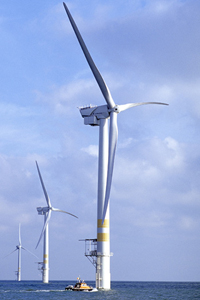There’s a divide over this issue among the locals living on Cape Cod, and those who fish these waters. Proponents are clearly in favor of the inherent green energy nature of offshore wind farms, reducing their dependence on the fossil fuel burning plant in Sandwich, however fishermen are united in their belief that these farms will negatively impact the fishing grounds in this area.
A white paper written by Gero Vella, at the University of Liverpool’s Centre for Marine and Coastal Studies, indicates that vibration and noise associated with these farms will be of little consequence to the marine life near these installations. Lacking antifouling, the installations themselves will become reefs and will likely help to support the development of new marine ecosystems, increasing local fish populations.Secretary of the Interior Ken Salazar and Cape Wind Associates, LLC today signed the nation’s first lease for commercial wind energy development on the Outer Continental Shelf (OCS).
“This is the beginning of a new era for our Nation in offshore energy production,” Secretary Salazar said in a speech to the American Wind Energy Association in Atlantic City, New Jersey, where he signed the lease. “Responsibly developing this clean, renewable, domestic resource will stimulate investment in cutting-edge technology, create good, solid jobs for American workers, and promote our nation’s competitiveness, security, and prosperity.”“This is an important milestone in the development of offshore wind energy,” said Bureau of Ocean Energy Management, Regulation and Enforcement (BOEM) Director Michael R. Bromwich, whose agency is responsible for reviewing proposed renewable energy projects on the OCS. “This is the first chapter of what we hope will be a continuing story of offshore renewable energy development that will allow us to expand the nation’s energy resource portfolio. As we move forward, we hope to expedite the process of reviewing and approving such applications.”The area offered in the lease is comprised of 25 square miles on the OCS in Nantucket Sound offshore Massachusetts. The 130 planned wind turbines could generate a maximum electric output of 468 megawatts with an average anticipated output of 182 megawatts. At average expected production, Cape Wind could produce enough energy to power more than 200,000 homes in Massachusetts. The site of the project on Horseshoe Shoals lies outside shipping channels, ferry routes and flight paths but is adjacent to power-consuming coastal communities.

Posted via email from
.jpg)
No comments:
Post a Comment